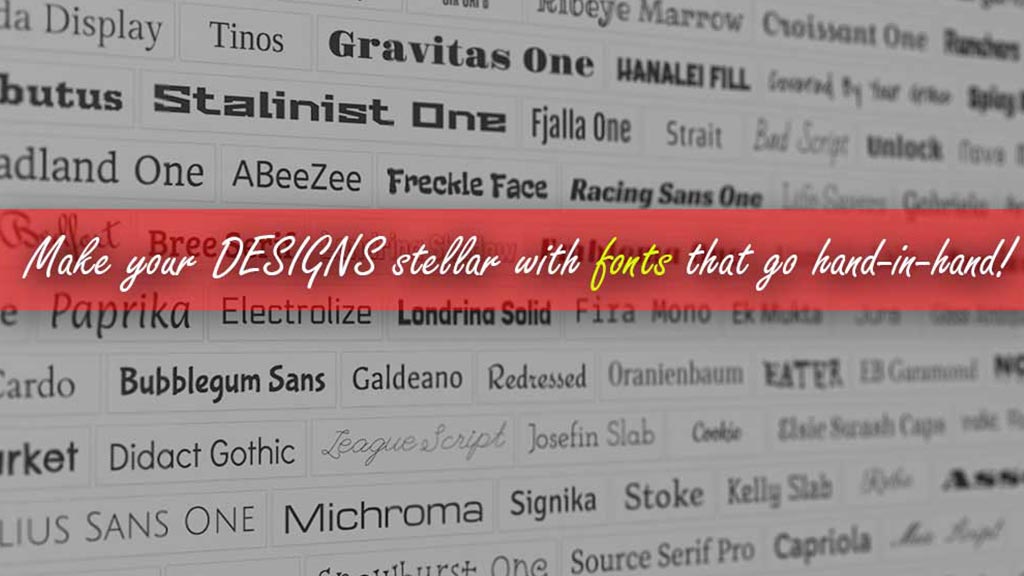Can you believe that 95% of graphic design depends on “Typography”? Yep, fonts can either make or break your entire website or poster. You may have carefully selected the layout of your site, choose the perfect color scheme, but if your fonts are wrong, you can be sure that people aren’t going to read it. Consider fonts as the all-powerful magical wand that can make a brand instantly recognizable.
Let’s pause and do a simple exercise here. Close your eyes and think of Disney. Now, it’s confession time. Is the first thing that popped into your mind the mouse that catapulted the company to fame? Or is it the stylish logo of the brand with the Trademark “D” and the curly “Y”? We’re sure it’s the latter. That’s the power of typography in a nutshell for you.
Pairing Fonts together isn’t Dark Arts, it’s Science
Selecting the right font and combining two fonts together is an intimidating task even for seasoned designers. Have you ever noticed that most graphic artists stick to just a couple of fonts for all their designs? Yes, fonts can be expensive, but the main reason behind this is pairing fonts can be a hassle. There is a science to font selection and choosing the right fonts to go together. Fonts that you select for the heading, subheading, and content have the power to determine the tone of your message, and ultimately it impacts your brand.
Confused with all the rules and implications? Worry not, here in this article, we break down the rules of font pairings and help you find the best ones to suit your message and content. We also give you a cheat sheet of fonts that work together. You can use these the next time you’re stumped halfway through your design.
Let’s get started! First, before you decide to pair fonts, let’s get the basics right.
How to Select a Font?
One of the crucial steps in your entire design process is choosing the right font. Here’s how to do that.
Content
The rule of thumb here is that the font you pick must suit the content or message you want to convey. Content is the most important element in any design. Sadly, most amateur designers make the mistake of regaling it to the latter half of the design process. Remember that if you have no message to convey, then there is no need for design.
So, decide on the font based on the content type. Is it a headline or will it be a sub-note? Is the message professional sounding or fun and informal? Will the message be placed along with a logo? Ask these questions to help you get started.
Character
If you think how something abstract as a font can have character, then you’re mistaken. Fonts like the Helvetica are pretty generic and don’t signify anything. On the contrary, other fonts bring forth memories and associations. The moment you take a look at the cursive Spencerian Script, the first image that pops into your mind is that of “Coca-Cola”. Likewise, several fonts have different characters or trigger various associations. When you select a font for your design, ensure that the character of the script matches that of your message.
Above all, remember that selecting the right font is all about listening to your gut instincts. Sometimes, while designing you get the feeling that something is off with the font. Then simply swap out the font and try again, till you find the one that feels just right.
Tips for Font Pairing
Now, that you have got the gist of how to select the right font for your design, let’s move on to the next step of the process. The much-awaited guide to font pairing.
One mistake most inexperienced designers make is to use several fonts in a single design. Have you heard the old saying, “Too many cooks spoil the broth”? The same goes for fonts. Just stick to one or two fonts or at the max three. More than that, you’re headed for disaster.
Another trick is to create a style guide. This is nothing but assigning different font sets that you can repeatedly use in all your designs. To create a comprehensive style guide, you have to assign fonts for the following:
- Headlines and subheadings
- Paragraphs (Body Text)
- Functional elements (like buttons, metadata, notes)
TIP 1: DON’T UNDERESTIMATE THE POWER OF CONTRAST/
Contrast has a vital role in all graphic design. It’s your way to make your design stand out and to stop it from being dull and boring. Just like you add visual contrast to your design, you should strive to add a touch of textural contrast.
If your heading and body text fonts are too similar, then you can be sure that it loses the required impact. Pair fonts that differ in thickness, width, and style. For instance, pairing “Serif” and “Sans-Serif” works well. However, keep in mind, that they should contrast each other. If one font has more characters, keep the other one generic for the most visual impact.
TIP 2: MAKE USE OF TYPE FOUNDRY
Figuring out if two fonts have sufficient contrast can be a pretty daunting task, especially for beginners. One easy way to do this is to make use of two fonts made by the same “Type Foundry”. A type foundry is nothing but a company that designs and sells fonts for a price or for free.
Or you can use a typeface, a family of fonts. Select a particular typeface and pick two different fonts from it. For instance, Arial and Arial Black belong to the same typeface but contrast and complement each other pretty well.
TIP 3: PROVIDE A VISUAL HIERARCHY
Pick up a newspaper or magazine lying near you and take a look at any random page. You can see the visual hierarchy in play. Traditional print media makes use of fonts to separate different parts of the text like headlines, sub-headings, body, and captions. This gives a subtle message to your eyes and makes them focus on the most important page of the content.
This is done by altering the size, boldness, spacing of the fonts to make readers navigate the page as the message intends. Visual hierarchy needn’t be limited only to designs with specific layouts. Even for advertisements or promotional posters on social media, you can employ this tactic to make the most important message reach the user first. This hooks in the attention of the reader and persuades them to read more.
TIP 4: CONSIDER THE X-HEIGHT
Another established way to pair fonts is to compare them by their X-height. This is nothing but the height of the character “X” in different fonts. It usually varies from one font to the other. The unwritten rule here is that fonts that have the same “X-height” will complement each other and work together.
TIP 5: AVOID PAIRING FONTS THAT ARE TOO CONFLICTING OR TOO SIMILAR
If two fonts are too similar, then your design will look monotonous and feel dull. Similarly, if two fonts are conflicting, then it makes your design look chaotic.
5 Font Combos that Look Stunning
To help you get started, here we give you a list of five font pairs that work well together.
THE BOTTOM LINE
We have come to the end of our introduction to font pairing. Bear in mind, that typography and matching fonts are crucial to the success of your designs. With that said, you also have to remember that poorly designed typefaces often don’t work well. So, instead of sticking to poorly designed free fonts, you can make your designs stunning by paying a small fee for stylish, premium fonts. In fact, successful designers have personal font libraries that contain a list of the best fonts that work together.
If you’re keen to create eye-popping designs, then it’s time to hone your Typography skills and create your personal font directory.
Are you planning to build a website? Our skilled team of expert designers and developers has worked on several website designing projects and knows the ins and outs of designing. Hop aboard with us and watch your sales grow and build your Website! For web designing services in Gurgaon, you can call us at +91 124-4379-633. We are also available 24×7 at www.webfries.com.


